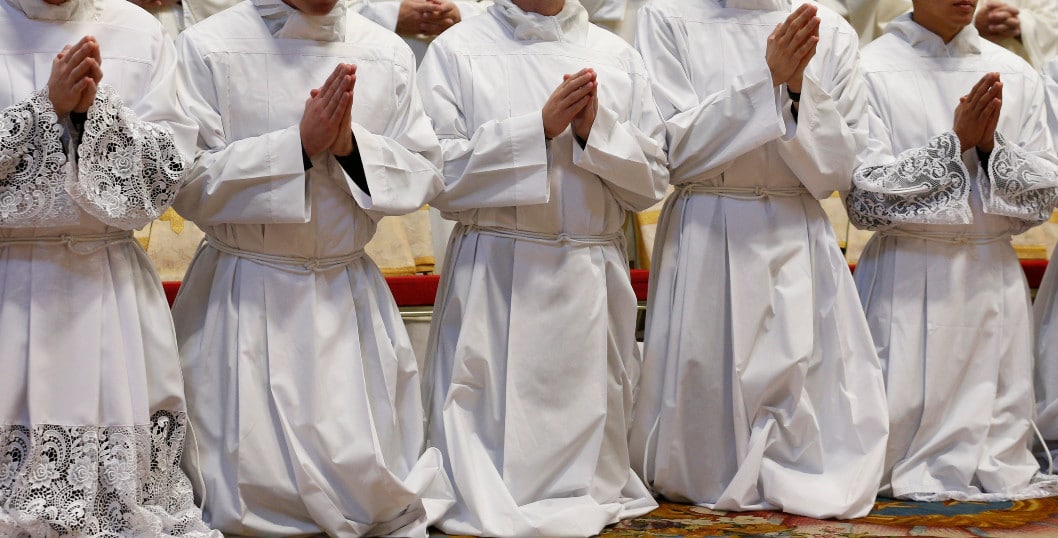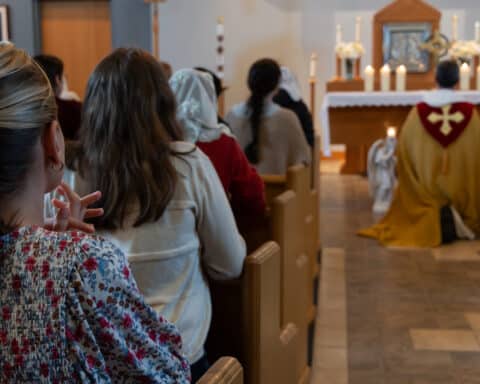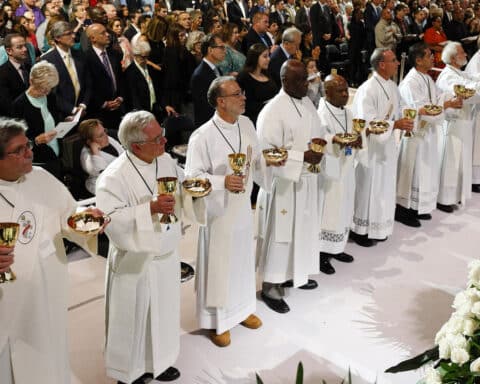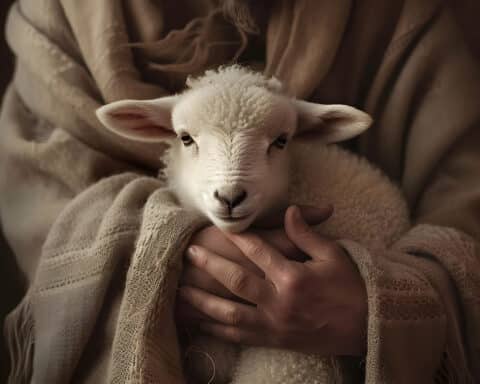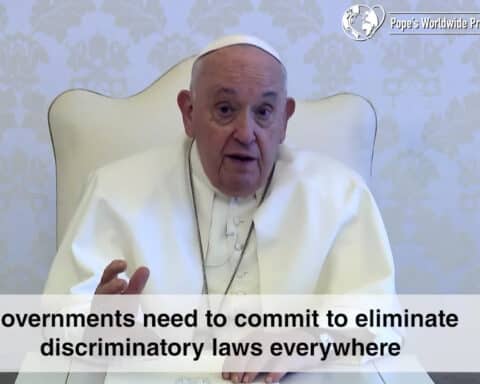In August 2016, a commission was formed in order to look at questions that were raised with regard to women and the diaconate by the International Union of Superiors General, who asked Pope Francis about it in a May 2016 audience they had with the Holy Father. This first commission was held and examined primarily the historical question. The result of that commission was that they were at odds with one another. There was no consensus. In fact, the quote from Pope Francis is that they were “toads from different wells.”
Then, following the Amazon synod, which again raised the question of admitting women to the diaconate, Pope Francis formed a Second Study Commission. In his closing address at that synod, Pope Francis said that he was open to “the request to reconvene the commission and perhaps expand it with new members in order to continue to study the permanent diaconate that existed in the early Church.” The new commission was formed in April 2020, and the results of the commission have not yet been released by the Holy See.
Commission member Deacon Dominic Cerrato, editor of OSV’s The Deacon magazine, agreed to speak with Our Sunday Visitor, not in his capacity as a commission member but as a private theologian interested regarding questions concerning the diaconate today. The interview was edited for length and clarity.
A Vatican commission on the diaconate
Our Sunday Visitor: How did you find yourself serving on this commission?
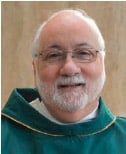
Deacon Dominic Cerrato: This is going back a couple of years, just a year before the commission. I’m sitting down in my prayer chair, doing morning prayer, and my phone is on my desk and it is just buzzing all over the place. And I thought, “I don’t have to anoint anyone; There’s no reason for me to get up.” So I finished morning prayer, and I decided to go over to my computer, and I see: “Congratulations. Congratulations. Congratulations.”
I followed a link that had been sent, and there was my name on the Vatican press release. It was a great honor to be on the commission, but I was simply chosen, primarily owing to the writings I’ve done on the diaconate. I suspect, too, that the Vatican wanted to put a deacon from the United States on the commission because the United States has the largest number of deacons, and this is, after all, a commission on the diaconate. So to not have a deacon, at least someone who understands the sacramental theology, on the commission would have been a mistake.
Our Sunday Visitor: One theological view that has been expressed is that the question of women receiving holy orders is answered in the negative for two reasons. The first reason is that Christ as a man is the head of the Church and is the bridegroom of his bride. The second reason given is that women can’t image Christ. But there’s a bit of a question about this narrative, so I’d like to hear you unpack especially this latter question.
Deacon Cerrato: This second question is sometimes called the iconic argument. And I think the Holy Father, most recently in an interview with America Magazine, recast or took up other terms, particularly with respect to his reference to the Petrine and the Marian office. But there is a complementarity that arises precisely out of the image of God who created man in his image and likeness, he created male and female. He created them. So in imaging God, there is this sense of the nuptial relationship which is inscribed in the very fabric of our being.
It’s one of the biggest models of the Old Testament, and it certainly comes through in the New Testament, Christ being the male and the Church being the female. And in a certain sense, because they’re male and female together, they reflect something of God that neither can apart. Of course Christ can reflect God most fully. But in coming together there is an argument, which I find quite compelling, that there is a complementarity. Equality doesn’t mean sameness. That’s critical. I think this is lost today in the gender arguments that our society is having today.
I think the iconic argument means something as to why women can’t be admitted to ordained ministry. In that recent interview in America magazine, the Holy Father said, “And why can a woman not enter ordained ministry? It is because the Petrine principle has no place for that.” Notice that, the pope doesn’t say the priesthood, he says ordained ministry, and he says, because it has no place in the Petrine office, meaning that it’s not there in Divine Revelation.
So he can’t. He can’t just make it up out of whole cloth. So it seems to me that the Holy Father is signaling something here. And certainly — given the reaction of many of the feminist groups that are pushing for this, calling him a misogynist mansplaining and all that kind of thing — it would suggest that.
Our Sunday Visitor: What would it look like to develop the Marian office? To further develop the Marian aspect in the life of the Church?
Deacon Cerrato: I would point to Mulieris Dignitatem, the Holy Father John Paul II’s work that offers a way to develop the Marian office. Also his 1987 Christmas address where he describes this before the Marian year. So there is a foundation laid for that, but you’re not going to get it if all of the focus has been on the Petrine, the more institutional Church and so forth. We need to revisit this Marian aspect in order to see the complementarity.
Our Sunday Visitor: But what about the question of women imaging Christ?
Deacon Cerrato: I’ve heard it suggested — and I I don’t think there’s much merit in it — that because women can’t be priests or deacons, that they can’t be admitted to holy orders, they can’t image Christ. That’s simply not true. And I think that’s a straw man argument.
Women can image Christ by virtue of their baptism. The question is not whether they can, it’s how they can. I’ve not been called to image Christ the priest. I’ve not been called to it, but that doesn’t mean I don’t image Christ. Every Christian images Christ, and we could even say that every person born, at least implicitly, images Christ. So God, who created that person and impressed that person with his image, even if that person is not Christian, bears something of the latent Christ that was brought out in baptism. So I find that argument not very compelling, not compelling at all, in fact.
Women leaders in the Church
Our Sunday Visitor: Many of the faithful are asking questions about the nature of the role of women in leadership in the Church. Were there moments in your work as a theologian and in your service to the commission that you saw places where you thought women would be leaders in the Church?
Deacon Cerrato: I think you begin first by building a theological foundation on what is the contribution of women. And John Paul II deals with that issue in Mulieris Dignitatem. Women have a unique contribution, and sometimes that contribution falls on deaf ears in a society in which motherhood is seen as debased and unimportant. From the receptiveness that Mary showed in her fiat, a theological foundation has to be built and understood before we can talk about that.
But you know, leadership in the Church properly understood is servant leadership. It’s a reverse structure. The clergy are there to serve the people. It isn’t about power. I’m a permanent deacon. I don’t have power. My wife has more power than I have. Here’s the power I exercise: the power of love. The power of service, which every baptized person has.
I think there is a way — and I have written about this a little bit, but it needs to be developed further — we speak in the Church about two participations in the one priesthood of Christ.
There is the hierarchical and ministerial priesthood, right? And then there’s the priests of the laity, or of the common or royal priesthood, as they are often called. Both are priests in the sense that they participate in Christ’s priesthood.
I suspect, if the theology of the deacon is developed, we could say that there are two participations in the one diakonia of Christ. Remember, he identifies himself as, first, death and says I came not to be served, but to serve (diakonos), and then give my life as ransom for many (sacerdos). So diakonos and sacerdos, the priesthood and the diaconate come together and find their nexus in the one Christ. So if there is a ministerial diaconate parallel to the priesthood, could there not also be a diakonia of the faithful?
Our Sunday Visitor: Part of what the Church does when she clarifies her teaching by the work of theological commissions and this sort of this sort of thing is that she rules out errors. Do you think that there are any significant errors about the nature of the diaconate, as such, that have led to the conversation about women participating in the diaconate, or to other confusions about the diaconate?
Deacon Cerrato: What’s happening here is that we’re trying to respond to a theological question with a sociological response. Wouldn’t it be great if women were deacons? Well, if that’s the will of God, because, see, it’s not what I want. It’s not what somebody else wants. It’s about the will of God. Well, where do we find the will of God? We find it in the sources of revelation interpreted by the magisterium. That’s where we find the will of God.
A lot of times, for example, it’s often quoted that the first person with the title “Deacon” is Phoebe in the book of Romans. Wait a minute. The term diakonos meant servant, and in most biblical translations she’s the servant Phoebe, not the deacon Phoebe. So there is a misunderstanding of Scripture. Well, where do we go? We go to the mind of the Church.
The historical question of deaconesses
Our Sunday Visitor: Right, but some say that the question of admitting women to the diaconate, because of the historical evidence for deaconesses, is one of discipline not doctrine. How do you respond to that?
Deacon Cerrato: Discipline is the application of the doctrine already done right, already confirmed. So in a certain sense, we could change the discipline as they did with the diaconate in making it a permanent thing to allow married men to be ordained. That’s a change in the discipline, which, by the way, is required, or at least an ecumenical council was used to do that.
The question of women in the diaconate is really more of a question of doctrine. It’s much more a question of doctrine, because, while there were deaconesses in the early Church — of that, there is no doubt — the question is not whether there were deaconesses in the early Church, but whether they were the male equivalents. And I’ll give you five reasons, or five general broad categories, as to why that was not the case.
First, the ordination rites were different. Ordination means to be enrolled in an order. It’s now come to be understood as holy orders. But if you look at the order, they are orders of virgins. They are the orders of widows. They were all kinds of orders. While the ordination rites of the deaconesses had similarities to that of the deacon, they were different. Because they were just similarities, it doesn’t mean that they’re the same.
[Considering] the role in liturgy shortly after the ordination, the deacon would participate in assisting at the sacrifice of the Mass. That was not the case of the deaconesses.
Their role in ministry. They didn’t have the same role in ministry. They ministered to women. They assisted at baptisms because they were done in the nude. They catechized women, and so they had a very limited ministerial function.
Deaconesses didn’t administer sacraments in the same way as the deacons were doing, and even as those sacraments developed, they didn’t develop along with it.
Finally, they differed in their relationship to the bishop. This is really critical: The dalmatic, the garment of the deacon, is the undergarment of the bishop. It shows the closeness. There is a filial relationship there. So there was a fundamental difference in what were called deaconesses and deacons.
One of my commission members who’s done a lot of work in patristics and the classics says the word diaconate, the term “diaconate,” was never used to include women. It was never used in the tradition to do that. And the Council of Nicea said they weren’t part of the clergy — no small council at that! So those are some key differences. There’s no strict parallel in the tradition between deacons and deaconesses.
Ordaining women to the permanent diaconate, as we understand it now, is not restoring that which was, it’s making something new. If that’s the case, then we need to find strong theological grounding for that [the ordination of women] in the sources of revelation, which need to be affirmed by the magisterium. Absent that, we can’t call it Catholic.
Father Patrick Briscoe, OP, is editor of Our Sunday Visitor. Follow him on Twitter @PatrickMaryOP.

